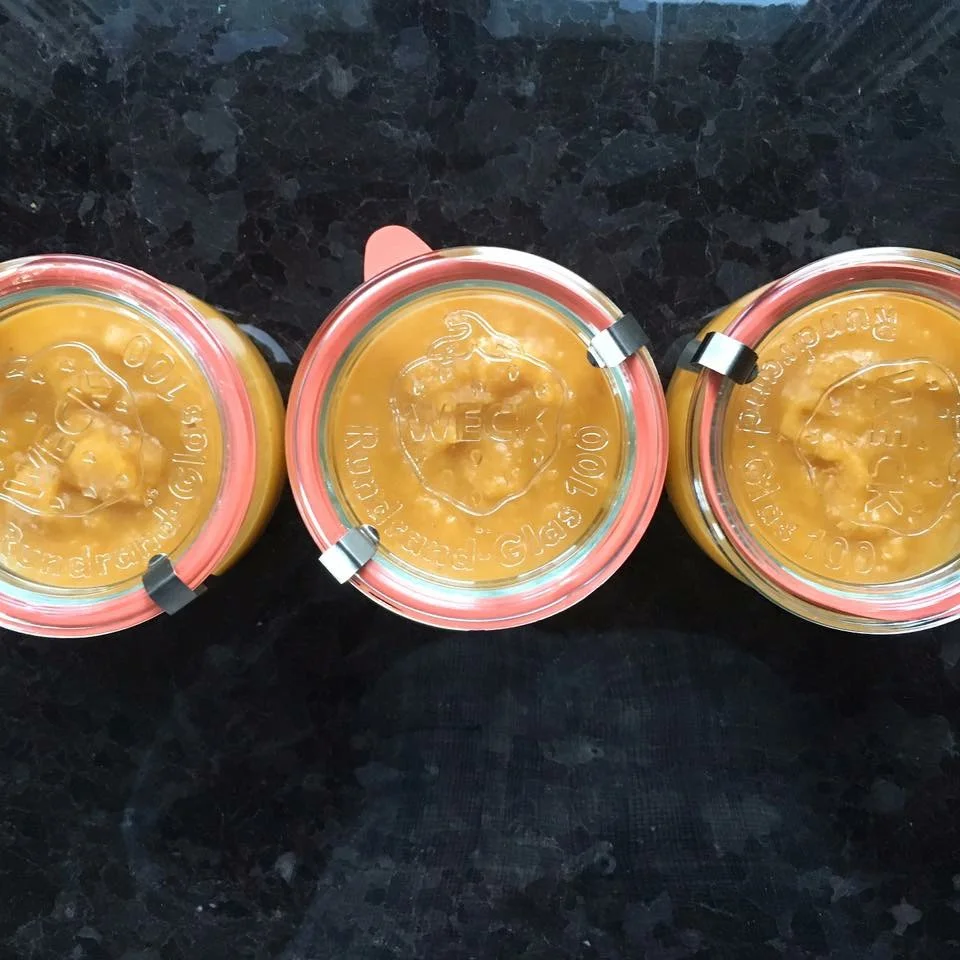Butternut Squash Soup

I know that many people find vegetable eating to be at its peak in the summer. The corn. The summer squashes. The leafy greens. The peppers. THE TOMATOES.
I prefer fall vegetables. Give me a winter squash or sweet potatoes, and I will find a way to eat it every day. Maybe twice a day. Can you turn orange from eating squash twice a day? Perhaps? Oh, well.
Lucky for me that I’ve been getting lovely butternut squashes in my CSA box lately. So much orange!
One drawback to dealing with a whole butternut squash: how to cut it. It takes some kitchen muscles and a good grip on your knife so as to not risk your fingers.
And if you’re me, there’s the ensuing butternut squash rash on your hands.
No? Your hands don’t get all tight and peeling like glue’s been poured on them and then dried there after handling butternut squash? And it lasts for hours? Just me? Um, OK.
(Insert awkward silence).
Anyway, there are two ways to deal with a whole squash:
- Cut it in half, scoop out the seeds, place the halves cut side down in a pan with some water, roast until the skin is easily pierced with a fork, let cool a bit, and then scoop out the flesh.
- Cut and peel the entire squash into chunks, toss the chunks with olive oil, roast until pieces are easily pierced with a fork.
I tend to prefer method #2, despite it being more dangerous to my knife-averse fingers and time-consuming upfront. Chunks of squash are done after 20-30 minutes, but halved squash can take over an hour to cook. Using method #1 also means that you really can’t do much with the squash except puree or mash it. Method #2 gives you some flexibility. Roast with a lovely mix of other root vegetables and herbs and top with a fried egg? Toss into a kale salad with diced apples, pomegranate arils, and a sweet vinaigrette? Mix into pasta with some dark leafy greens and walnuts or a flavorful cheese (like goat cheese)? It’s good to have choices.
Either way, use your sturdiest and biggest knife, and put some muscle behind cutting the squash. Use a spoon to scoop out the seeds and stringy flesh around them. I’ve heard that the seeds can be cleaned and roasted, but I’m an honest woman, and I’ll tell you that I did that this week, and it was grody. If you’ve successfully roasted squash seeds, tell me your ways!
If you’re cutting the squash into chunks, I’ve found it easier to remove the skin when the squash is in larger pieces rather than cutting the whole thing up and then trying to remove the skin. I like to separate the bulb from the neck, cut the neck into a few thick rings, cut the bulb in half and then into quarters and deal with the skin from there.
There is also the gloriously easy option: buy a package of pre-cut butternut squash in the refrigerated produce section at the grocery store. No knives or muscles needed, no fingers risked, no weird squash rash. (Seriously, I looked it up on the internet, and this is a thing. For real).
Today I’m sharing with you my current favorite way to eat butternut squash: the humble soup. Made with only four ingredients minus seasoning, it is delicious, easy, and amenable to many dietary restrictions. Most important to me, it is very, very orange.
I love to make a batch of this for myself to eat throughout the week for lunch. Probably my favorite way to eat it is with a dollop of pesto in it and Triscuits on the side for dipping. If you’ve got someone in your life who might need a wee bit of convincing to eat such a purely vegetable soup, it is perfectly acceptable to reduce the vegetable broth by a 1/4 or 1/2 cup and substitute an equal amount of cream or half and half; make sure to add it at the end so that it doesn’t curdle in the soup.
Butternut Squash Soup
Ingredients:
2 pounds peeled and cubed butternut squash
2 medium yellow onions, cut into 2” chunks
1 - 2 tablespoons olive oil
1 teaspoon kosher salt
Pepper to taste
2 - 1/4 cups vegetable broth
Directions:
Preheat oven to 400 degrees. In a large bowl, toss the squash and onions with 1 tablespoon of olive oil, the salt, and pepper to your liking. If veggies don’t seem evenly coated with oil, drizzle in a bit more. Distribute into a single layer on a large rimmed baking sheet. Place in oven, flipping veggies over once or twice during cooking, and roast until squash is easily pierced with a fork, and onions are tender and slightly browned. (Cooking time will vary depending on the size of your squash chunks; I like to check roasting progress every 10 minutes or so.) Remove from oven, and let cool slightly.
Place roasted veggies and vegetable broth in a blender and puree until smooth. Transfer puree from blender to a medium pot; heat over medium-low until heated through. If using cream, add now, and heat an additional minute or so. Season to taste with additional salt and pepper as needed. Yield: 3 - 4 generous servings, depending on your liking for orange.




